There are really no words we can use to accurately describe our experience into Spiti Valley, Himachal Pradesh, India. Where Iceland filled our top spot for sheer scenic beauty, the Spiti Valley may have just eclipsed it, not only for scenery, but also for cultural experiences. Check out our Iceland post by clicking here.
Spiti Valley is a gem. Our experience… priceless.
The Spiti Valley lies around 3680 metres above sea level. Ancient civilizations and incredible monasteries have existed in the valley for a thousand years. The valley only opened to foreigners in 1992. Some of the most remote villages in India are in the Spiti Valley and they continue to be cut off from the rest of the world during winter for six months of the year.
We chose to book a package with a local adventure company. For six days, we had a driver and vehicle, no frills accommodation, breakfast and dinner. Concerned that the nights were going to be chilly, around 10C and that our Southeast Asia clothes were not going to help, we purchased two-dollar fleece toques and a three-dollar fleece shirt for Christine. Toasty.
Day 1 – Getting there (12 hours, 202 kms)
Our first day began with Vikash, our driver, picking us up at 5:00 am in a raised Toyota Innova. From the beginning, it felt like all we did was climb. The Toyota diesel engine clanked away, but never complained or emitted a puff of black smoke.
Spiti Valley is often referred to as a piece of Tibet marooned in India. We were quickly above treeline looking out amidst moonscape-like land surrounded by jagged mountains in a dizzying array of colours, shapes, sizes and composition, while snowy peaks stretched to the sky. Along the route, the Chanab and Spiti River never seemed far and their earthly beauty contributed to our most famous Spiti expressions such as WOW, OMG, I can’t believe this, have you ever seen anything so BEAUTIFUL and Awesome! The drive we completed is one of Asia’s great road trips and is listed as one of the most dangerous.
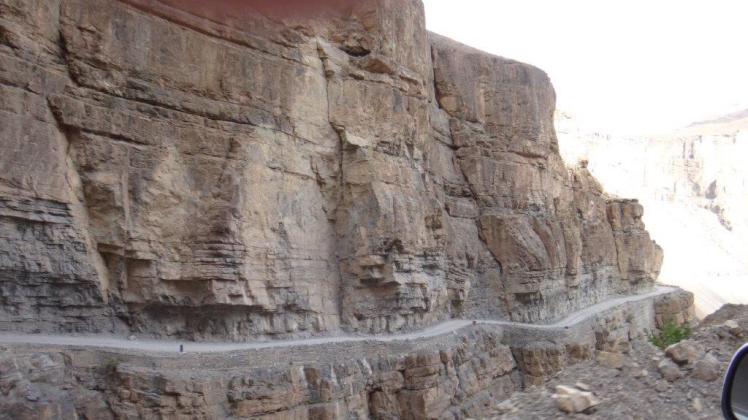

Twelve hours of driving on a single-track road with precipitous drops, hairpin turns, detours due to road washouts and Vikash stating in his thick Indian accent “this section very dangerous” gave an entirely new meaning to the expression, I just shit my pants. Mark breaks into Diana Ross’s song “Do You Know”, but changes the lyrics thinking of one of his mom’s favourite sayings, “do you know where your children are?”.
We completed two passes the first day during the 202 km drive from Manali to Kaza. The Rohtang pass (4,116 metres) and Kunzum La (4,550 metres).
Stupas strewn with windswept prayer flags marked the summit and our vehicle, like all vehicles that reach the summit, drove around the stupas as a gesture of respect and thanks for a safe journey. Our passports and identification were checked at the halfway village of Losar due to the proximity of our location to Tibet/China. The rest of the journey was free sailing into our home base located in Kaza.
For snacks on the journey there were a few stone dhabas offering delicious chai, dahl and rice. So simple, but with an unmatched experience.
We checked into our “home” for five days. The room was clean but appeared a bit old, blankets were thick and heavy in order to keep the nights chilly 10C off of us, electricity had not been turned on from the government and heaters did not exist. The room did not have a shower, “only bucket wash” the gentleman (Dilwag) said. We both nearly dropped to the floor as we stood there shivering. Thankfully a room with a shower was available and we moved. Still no electricity, no internet, no cell coverage, no heat, no hot water to the sink and two single beds (a sheet of plywood with a two-inch mattress) pushed together. We knew it was going to be a challenge. The running joke we had with the fantastic men employed at the hotel was that one of them was going to have to teach Mark how to bucket wash. A normal way of life for them, they laughed at Mark every time any discussions arose around having a hot shower. On the second day, Mark had a brilliant idea (wink) and purchased a few candles to provide a little bit of heat in the room and to provide light when the electricity was out. Mark blogged the old fashion way with pen to paper, often under blankets, headlight on and the candles glowing orange in the room. The silence at night was deafening.

Day 2 – Komik, Hikkum, Langza
The following morning we set out for Komik, the highest motorable village in Asia at 4513 metres.
The Tangyud Gompa (monastery) founded in the 14th century is home to around fifty monks. Mark was able to enter the monastery but no woman are permitted. A stuffed snow leopard suspended over the entranceway to the prayer rooms provided protection. The air was thick with incense, murals were painted on the wall, drums hung suspended from the ceiling and gold horns sat in the corner. No photos were allowed, images must be burnt into memory. Honestly, there will be no forgetting the feeling of walking into an ancient monastery around 4000 metres in the Himalayas. This was just one of many moments where the feeling of being the luckiest man alive came to mind.
Next stop, Hikkum, home to the world’s highest post office at 4,440 metres.
Up to this point, aside from a slight headache, the elevation had not affected us too badly. However, at 4,440 metres, we huffed and gasped for air on the slightest of hills. Mr. Chhopel, the postmaster and post office/home owner, sat with us and discussed what life is like in his village. He is thirty-two years old, he has lived in Hikkum his entire life and he has three children (11, 8, 6 years of age).
They hike three hours straight downhill to deliver and pick up mail at the central post office in Kaza. Mark asked, he is of Mongolian descent. We write three postcards and it cost 120 rupees ($2.33 CDN) including stamps. Mr. Chhopel had recently run out of stamps, but insured us he will mail our postcards when the stamps arrive. He had a peace and deep, deep, kindness that oozed from his being, we both left Hikkum feeling incredibly blessed for our experience.
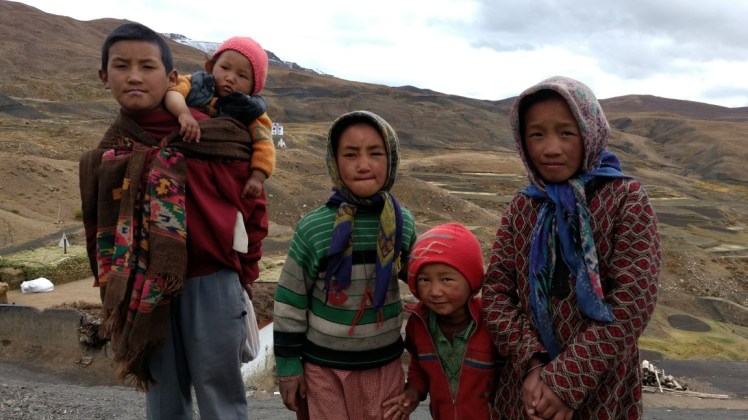
Switchback roads and crazy hair pin turns then brought us to the village of Langza at 4,325 metres. The Lang temple in Langza is estimated to be a thousand years old. A giant Buddha sits proudly on a barren hill overlooking the Spiti Valley while the mountain peak of Chau Chau at 6,300 metres towers over the village.
Further, the area is rich in ammonite fossils around one hundred million years old, but as we walked around in amazement, young children laughed and played marbles on the gravel road and they appeared completely oblivious to these foreigners and the incredible scenery around them.
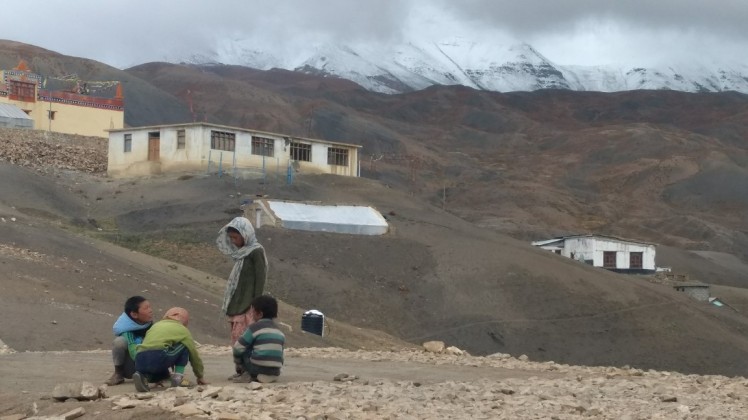
That evening we share stories with the hotel staff, eat an incredible home cooked Indian meal, laugh and then crawl into our chilly room eager to begin a new day. At this point, Mark still cannot fathom a bucket shower in the cool temperatures and no one has showed him how, and that is A-ok.
Day 3 – Pin Valley
Possibly the absolute highlight of the Spiti Valley, the Pin Valley roadway is an incredibly scenic, beautiful, jaw dropping, goosebumps provoking drive. Not due to drops and cliffs, this national park area is about raw beauty full of jagged and smooth mountains. Rare plants flower, green and yellow leafed trees rustle (an oddity in the Spiti Valley) and the crystal clear Pin River follows the roadway to the end of the line at the quaint, picturesque Mudh village (3794 metres). The park is home to at least twelve endangered snow leopards as well as siberian ibex, bharal, weasels, red foxes, yaks and numerous birds.
Early in the trip, we provided a ride to a local teacher hitchhiking her way to work in the Pin Valley. A regular way of life in the valley, she sat in the front seat where she could communicate with our driver while we all enjoyed the drive. What felt like in the middle of nowhere, she signaled our driver to stop and we watched her walk into a tiny, empty looking school. Our destination was literally the end of the road where Mudh Village sits waiting for die hard outdoors people to begin one of the many hikes available from the village.
On our way back, we give a ride to a Tibetan, wrinkly looking man travelling several kilometres down the road to his home village. He was in Mudh to deliver wedding invitations for a wedding that will take place in three days! He tells our driver they expect 240 people to attend the wedding. When we ask how they will get to Mudh, we are told twelve people at a time will squeeze into a car. The bright red with gold lettering wedding invitation was of the highest quality we have seen. We bid him farewell and watched him cross a rickety old bridge over the Pin River to a dusty, twisted trail heading up into his village on the mountain slopes.
Hidden around a hairpin turn just off the road was the unexpected and truly incredible Kungri Monastery. A large event just happened to be taking place that day and the monastery was jam packed full of monks, children, locals and us two white roaming folk. Speakers throughout the grounds echoed with the sounds of chanting monks that prickled our skin and made our arm hairs stand straight up. Children ran around a giant prayer wheel while young monks-in-training walked by with their tin of chai tea offering drinks to everyone they saw. We will just say, it was an unforgettable moment.
Day 4 – Tabo, Dhankar, Lhalung
Once again, we were treated to an incredibly gorgeous day. The blue sky in Spiti Valley is like a blue we have never seen. Free from pollution or perhaps it was the elevation, we do not know, but it is the most beautiful blue color.

We passed local ladies each with their tea cup walking to see a visiting monk. Smiles all around.
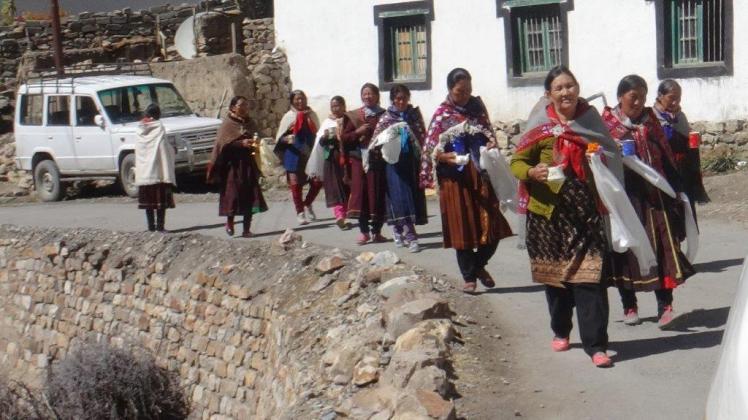
We drove to Tabo, home of the famous UNESCO listed Tabo Monastery which is more than 1010 years old (AD 996). The monastery covers 6300 square meters and is made of earthen clay walls. It is the oldest continuously functioning monastery in India. No photos were allowed or even cell phone lights. The dark interior provides protection to the incredible and precious Thankgka paintings, famous pillar of a thousand Buddhas and several frescoes. The ancient paintings depict the life cycle of Buddha and legends from the Jataka tales. Some of the paintings date back to tenth century and were painted by the best Buddhist muralists in India who blended Indian, Tibetan and Kashmiri styles. A number of caves in the mountainside above the monastery were once part of the complex. It is very clear once you arrive in Tabo that there is money in this village. A new monastery is being built, existing buildings are well maintained and new construction is present everywhere. Tabo is visited by his holiness the Dalai Lama and is also referred to as the Ajanta of the Himalayas; however, it turned out to be the least special of the Spiti Valley.
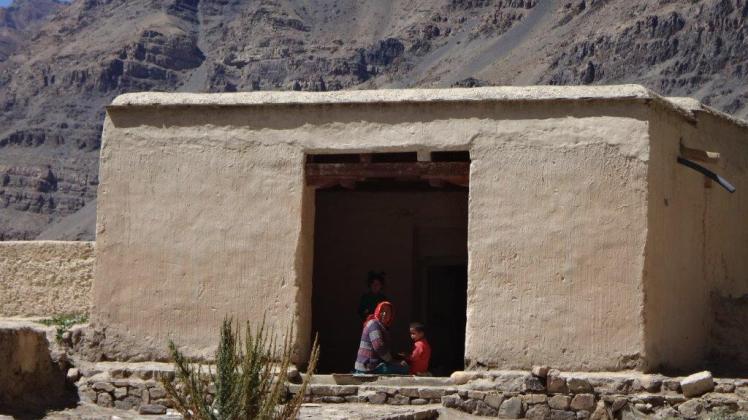
Next, the absolute most unforgettable, surreal, inspiring and beautiful 1200 year old Dhankar Monastery. If you think we would be bored with monasteries at this point, you would be dead wrong! An unbelievable setting, this monastery sits precariously between pinnacles that have been eroded longer than time itself.

The men who built this monastery are braver men than this roaming two. Steep stairs lead to an ancient shrine filled with ceremonial masks, a dark meditation cave where just the soft glow of a candle illuminates a photo of Dalai Lama, a room where his Holiness slept, and an incredible rooftop terrace. We sat and chatted with a monk and once again we never wanted to leave. We learned that all families in the region send their second born son to the monastery at a very young age to train to be a monk. As we leave, five monks enter the prayer room and begin their 3:00 pm prayers. I have goosebumps just writing this sentence. The sounds of their voices emitting from the concrete walls suspended thousands of feet above the valley below was phenomenal.
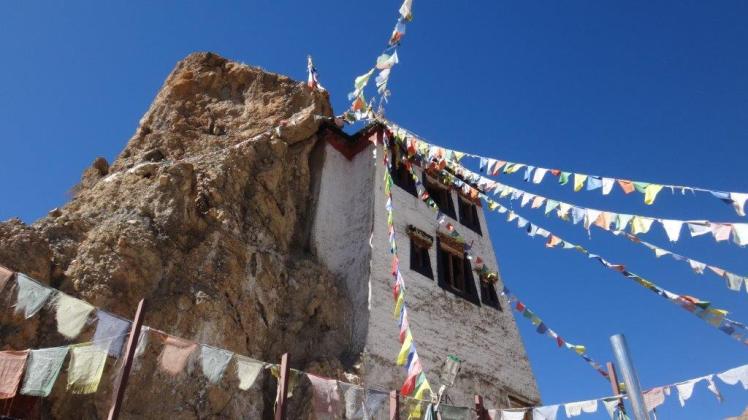
A short video of the monks.
It took everything in us to leave Dhankar monastery; however, our last stop for the day was one of the oldest monasteries located in the high-altitude village of Lhalung. An absolute medieval gem, the monastery is unassuming but what lurked inside blew our mind. We met the no-English, but oh so cute, caretaker who was kind enough to unlock the discoveries that lurked behind heavy doors. Superb old murals, ornate carved wood gods, a unique four-sided Buddha statue sitting atop snow lions, and a skin prayer wheel shocked us that something like these pieces of art could be so removed from the world.
The word Lhalung means ‘land of God’. The Tangmar Mountains tower over this scenic village. Locals will say the mountains transforms in colour depending on the mood of the deities. Red denotes anger while yellow signifies happiness. During our visit? The hills were alive in a vibrant yellow.

We returned to our room without power once again, but who cared, what an incredible, unforgettable day!
Day 5 – Ki, Gette, Kibber
Another gorgeous blue sky morning and our driver Vikash had his bucket shower (brrrr) and he had the Toyota Innova sparkling clean once again. The roads in Spiti Valley are dusty and by the end of each day, we can see the sand literally sitting on our pants. A slap on each other’s back and we laugh and cough from the dust floating around. The dash, windows, everything is filthy but Vikash had it all clean every morning.
Ki is home to the largest monastery in Spiti Valley. Home to around 300 senior and student monks, the monastery has a postcard perfect setting where it sits upon a cone shaped hill with 90 degree cliff faces in its backdrop. Situated at a height of 4,166 meters, the Ki monastery is famous as a prominent center of learning as well as a refuge for Tibetans. Its remote location atop a hill overlooking the endless plains of the Spiti Valley makes it an obvious choice for those seeking peace and calm. The Dalai Lama slept in a small room with an even smaller window overlooking the valley in 1960. The monks let us in the kitchen where they prepare food for around 180 monks on that particular day. The walls were thick and heavy with black soot from years of burning wood in the ovens. Oh what stories could likely be told.
We jumped back in our Toyota Innova and drove straight up to Gette. At 4,750 metres, we sat directly above the Ki Monastery. Beautiful, colourful prayer flags whipped violently from the winds being directed straight up the rock face. We snapped photos of prayer flags flying upwards against gravity and the ant-like Ki Monastery below us. It is good luck to build a cairn, so that was a must and we finally caught sightings of blue sheep.
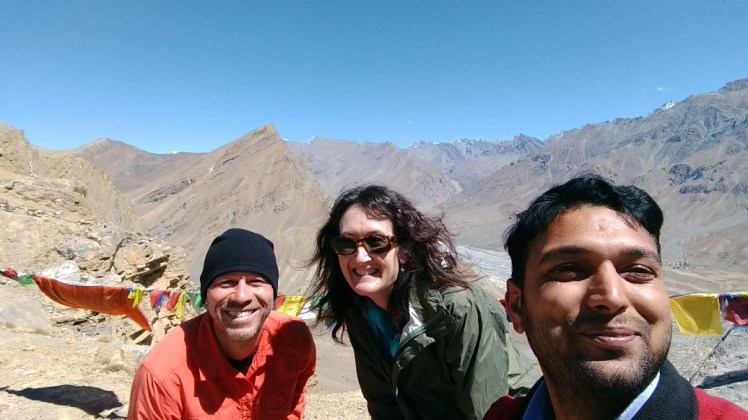

Our final stop was Kibber at 4,205 metres. It was formerly the highest permanently inhabited village of the Spiti region and it is a great starting point for treks lasting several days. We enjoyed a Chai tea with Vikash, snapped off a bunch of photos and called it a day early with a long twelve-hour drive back to Manali the following morning.
We said goodbye to the terrific group of guys (VJ, Dilwag, Dawa, Manoj) that we met working at our hotel and we stood out at night one last time. The stars literally twinkled. Like a sea of twinkling LED lights, we swear we have never seen night skies like the skies in the Spiti Valley.

Day 6 – We have to drive that road again!
The drive back to Manali was looong. We laughed at our heads bouncing around and once or twice hitting the window pillar. Vikash laughed at Mark, “ringing his bell” (ie. hitting head) and we took deep breaths as Vikash maneuvered through rushing water over the roadway while stating “oh my God”.
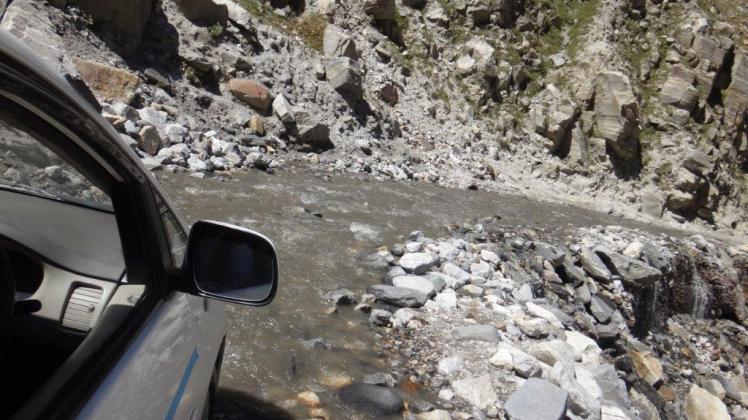
The road construction did not build our confidence… they just scrape the road over the cliff with a bulldozer.
With limited time and resources we put together this compilation video from our journey on the rough and unforgiving road. The editing isn’t good, but it is a glimpse.
The trip registers 39,430 steps and 737 stories on Mark’s FitBit. In six days, Mark snaps off 1500 photos, not including the 500 that were deleted from edits and Christine took an additional 1600 on her camera. Our wish? Return to the state of Himachal Pradesh and explore more of its Himalayan beauty… with heat, hot showers and a comfy bed.
The end of our Spiti Valley trip marks the end of our sixty-day visa in India. If we could, we would have stayed! Shocking because we would have never said that at the beginning of our India trip.
As we reflect on our time in India, we know chai tea will never taste the same. It is kind of crazy that parts of this country have an ambulance for cows while in other locations babies died in a hospital during our time here. Their deaths were due to a shortage of oxygen canisters in the hospital. The 18% tax is brutal, nothing more needs to be said about that. But eyes sparkle, teeth shine, and there is that incredibly awesome Indian head wobble that we have grown to love. Not sure if it means, yes, no, maybe, or you are so wrong; who cares, it is endearing, and we love it.
India – a country that truly challenges beliefs, tolerances, attitude, prejudices, stereotypes, senses and sensibilities. No other country we have visited comes close to the shock, awe and wonder that India stirs within.
We have been:
- Repulsed and then amazed,
- Sad and then happy,
- Broken down and whimpering and then energized and grateful.
There have never been so many ups and downs in one place. India is a real love it or hate it (to the extreme) kind of place.
Can’t wait to leave… but want to stay!
India. Love it ♥️
… Mark and Christine


























































































































Wow, my bucket list just got longer. Your high altitude stuff got me thinking about a mountain pass we crossed on our way to Chivay, Peru. According to the picture, 4910 metres! Certainly the highest road I have ever been on. A guy on the bus across the aisle from me passed out due to hypoxia. I remember seeing an oxygen container strapped to the floor of the bus behind the driver, so I went up to ask about using it. Empty, of course. The driver made up a concoction of rubbing alcohol from the first-aid kit mixed with leaves from a bush at roadside, rubbed it all together in his hands, then put it in front of the passed-out guys face for him to breath in. It revived him! Pic is with my daughter Megan and her husband Andrew.
Safe travels,
John B.
Sent from my Commodore 64
>
LikeLiked by 1 person
Hi John. Great to hear from you. Terrific story. We remember chewing fresh Coca leafs in Peru to prevent that from happening 😉. Good times indeed! Love, love, luv your email signature! How many kids ask you “what is a Commodore 64”? 😀
LikeLiked by 1 person
Terrific post- moving, Stark, overwhelming, fragile, – just like the landscape and the people. You two are having the time of your lives! wonderful! Thanks so much for taking the trouble to write it all down…. and share it😘
Xoxo Sandy & Marty
LikeLiked by 1 person
Hey Sandy and Marty … This is our way of convincing you and Marty to return to Himachal Pradesh with us 😉.
LikeLiked by 1 person
Hi Christine and Mark….I’ve been loving reading/travelling with you (through your blog) for your whole trip! I’ve never commented before but one part of the video make me laugh out loud. (at work Christine…and people are staring!!) That part where you are driving through the rushing water over the road….flash to the prayer flags….then back to the water! Hahahahahah please tell me that was on purpose!! Anyways, super amazing! Can’t wait for more! Laurel
LikeLiked by 1 person
Awesome! Love hearing people are watching the videos….even if it is while they are at work 😜. Will look you guys up in December/early January during our return to Canada for Xmas with family.
Now, get back to work!
LikeLiked by 1 person
Love the pic of you writing by candlelight Mark! Like some great explorer photographed during a reflective time.
LikeLiked by 1 person
Give me a head of hair and I suppose I could look like Sir Edmund Hillary 😀
LikeLiked by 1 person
It was nice to return to Spiti through your wonderful post. Cheers!
LikeLiked by 1 person
Thanks Simran. Spiti Valley is so gorgeous and special, I’m glad you were able to travel there again.
LikeLiked by 1 person
Simply amazing. I have to wonder at the journey the wood had to make to get up there – every piece of construction would have it’s own fantastical adventure attached I’m sure… It’s always great to hear of a trip ending on a high note – and the elevation of the valley couldn’t be any higher – happy for you both!!!
LikeLiked by 1 person
Great post. Makes me want to go to Spiti even more now. Have been to Ladakh, which is amazing. And you are right about India. My parents are Indian but I was born and raised in the U.S. and am now living in India for the past 3 years and I am “repulsed and amazed” on a daily basis:) I’m probably biased but I don’t think there is any place like it on earth.
LikeLiked by 1 person
Amazing post! I think this is the one that has swayed me into wanting to see India. What an experience but Laurel could hardly endure the roads in Iceland a due to his height fear. This may literally push him over the edge 🙂. Love the sign “First deserve then desire”. Great pics and videos.
LikeLiked by 1 person
Hi Mark and Christine Are you back in Kelowna? It would be wonderful to meet up with you. I feel it would be appropriate since I have been following you around for two years. Bless you for all the excellent posts! Marge Mitchell (Valley Rd Glenmore) Hope to hear from you.
LikeLiked by 1 person